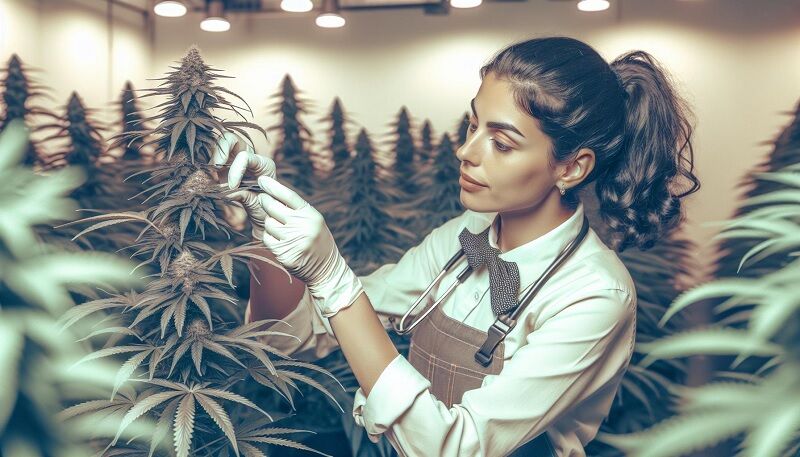Unlocking the secret of cannabis genetics

Different strains of cannabis bring a variety of experiences to the table, thanks to their unique genetic profiles. High THC levels, for example, lead to stronger psychoactive effects, while higher CBD levels are sought after for their therapeutic potential. Moreover, the genetic diversity among strains allows you to explore an extensive range of aromas and flavors, from fruity and floral to earthy and spicy. This genetic variability is what makes cannabis cultivation both a science and an art. Understanding these genetic influences can vastly improve your cultivation strategy, ensuring you produce the best possible crop.
Why genetics matter
When you dive into the world of cannabis cultivation, you’ll quickly realise the pivotal role genetics play. Cannabis genetics cultivation isn’t just a fancy phrase; it’s the cornerstone of success in producing high-quality cannabis. Every aspect that matters to you, from potency to aroma, ties back to the plant’s genetic profile.
First off, the unique genetic makeup of a cannabis plant directly impacts its THC and CBD levels. These compounds define the psychoactive effects and therapeutic potential, respectively. For instance, higher THC levels mean more potent psychoactive experiences. On the other hand, CBD is sought after for its health benefits without the high. Thus, understanding cannabis cultivation genetics is essential for tailoring the plant to meet specific requirements.
Moreover, it’s the genetics that determine the plant’s aroma and flavour, making each strain distinct. A mix of art and science goes into developing strains that can deliver a wide range of sensory experiences. This diversity is what makes cannabis cultivation so fascinating and rewarding. It’s about mastering the role of genetics in cannabis cultivation to maximize the plant’s potential in every aspect.
Advances in genetic tools have opened up new frontiers in cannabis cultivation. Techniques like CRISPR-Cas allow for precise edits to the plant’s DNA, enabling the development of strains with specific desired traits. These groundbreaking technologies highlight the importance of genetics in pushing the boundaries of what’s possible in cannabis cultivation.
Your success in cannabis genetics hinges on mastering these genetic principles. Each decision, from selecting the right strains to employing advanced genetic tools, influences the outcome of your cultivation efforts. As you continue to explore this vibrant field, remember that genetics isn’t just one of the factors; it’s the bedrock of success in cannabis genetics.
The importance of selecting the right strains

Your success in cannabis genetics significantly hinges on this choice. Each strain brings its own set of genetic blueprints to the table, dictating everything from growth patterns to cannabinoid content. This means that understanding the role of cannabis cultivation genetics isn’t just useful; it’s essential. For instance, if you’re after a plant that thrives in cooler climates or one that offers a quicker flowering time, your success lies in selecting genetics tailored to these preferences.
Selecting the Right Strain: The genetic makeup of your cannabis plants determines fundamental traits such as potency, flavour, and resistance to pests and diseases. Choosing genetics that aligns with your cultivation goals isn’t just advisable; it’s crucial.
Tailoring Your Cultivation Strategy: Knowing the genetic background of your cannabis plants allows you to tailor your cultivation techniques. Indica, Sativa, and hybrid strains each require different conditions to thrive. By aligning your growing conditions with the genetic requirements of your plants, you optimise growth and yields.
Maximising Potency and Yield:Cannabis cultivation genetics significantly influence cannabinoid and terpene profiles. Higher THC or CBD levels, for example, depend on picking the right genes. With strategic selection, you can not only meet market demands but exceed them.
Pest and Disease Resistance: Genetics also determine a plant’s resilience. Some strains are naturally more resistant to pests and diseases, which can be a game-changer in your cultivation process. Investing in such genetics means fewer losses and lower usage of pesticides.
Adapting to Climate: Your success in cannabis genetics also depends on choosing strains suited to your cultivation environment. Some strains fare better in specific climates than others. By selecting genetics that match your local conditions, you’ll ensure healthier plants and more robust harvests.
Sativa vs. Indica vs. Ruderalis: Genetic differences and growth characteristics
Lets dive into some important aspects that can help differentiate better between sativa vs indica and ruderalis
Sativa plants are tall and slender, with narrow leaves. They thrive in warm climates and have a longer flowering period compared to their counterparts. If you’re aiming for a strain known for its uplifting and energizing effects, Sativa’s genetics make it an ideal choice. Yet, remember, their size and longer cultivation time require more space and patience.
Indica strains, on the other hand, are shorter and bushier, making them perfect for indoor cultivation. With broad leaves and a quicker flowering cycle, Indicas are your go-to for a fast turn-around. The effects? They typically offer a more sedative experience, perfect for relaxation. Their resilience and compact size mean greater adaptability and ease in managing your cultivation space.
Then there’s Ruderalis, the wild card in cannabis cultivation genetics. Ruderalis is robust, auto-flowering, and can withstand harsh climates. Its genetics are often harnessed to develop auto-flowering hybrids, adding a layer of convenience since these plants flower based on age rather than light cycles. This attribute is particularly appealing if you’re looking to streamline your cultivation process.
Hybrid Vigor: The Science of crossbreeding for optimal cannabis growth
In your journey to understand the pivotal role of genetics in cannabis cultivation, it’s crucial to grasp the concept of hybrid vigor, also known as heterosis. This phenomenon occurs when crossing two diverse strains of cannabis leads to offspring that are genetically superior to their parents. You’ll find that this is not just about producing a robust plant; it’s about shaping the future of cannabis genetics cultivation.
Cannabis cultivation genetics play a central role in enhancing yield, resilience, and the overall quality of the crop. By selecting and crossbreeding specific strains, cultivators can develop plants that possess the desired traits of both parents, such as disease resistance, higher yield, and improved cannabinoid profiles. This is where your understanding of cannabis genetics becomes a powerful tool in your cultivation arsenal.
Embracing the science of crossbreeding can elevate your success in cannabis genetics. The goal isn’t just to mix and match genetics randomly but to do so with precision and strategic intent. For example, combining a Sativa strain known for its uplifting effects with an Indica strain famous for its sedative properties can yield a hybrid that balances both characteristics. This meticulous approach to selecting parent strains ensures the creation of hybrids that meet specific market demands and cultivation environments.
Hybrid vigor doesn’t stop at just enhancing physical growth attributes. It extends to increasing the plant’s ability to fend off pests and diseases, tolerating environmental stresses, and optimizing the concentration of cannabinoids and terpenes. Your intervention in the genetic makeup of your cannabis plants, therefore, directly influences their growth trajectory and the quality of the final product.
The impact of genetics on terpene profiles and cannabis aroma

The role of cannabis cultivation genetics isn’t just about the potency or effects; it’s also about crafting strains with appealing aromas. This is where the art and science of breeding come into play. By selecting parent plants with desirable terpene profiles, cultivators can influence the aromatic qualities of their offspring. This selective breeding not only caters to consumer preferences but also enhances the overall appeal and market value of the strain.
Moreover, success in cannabis genetics heavily relies on the understanding and manipulation of these genetic factors. Achieving a consistent terpene profile is a testament to a cultivator’s skill in genetics manipulation. It ensures that each batch of a particular strain provides the same aromatic experience, a key factor in consumer satisfaction and brand loyalty.
Considering the above shared details, Explore some awesome watering techniques for your cannabis, Growing cannabis in Thailand’s tropical climate presents unique challenges, especially when it comes to watering your plants. The temptation to overwater is real, given the country’s intense humidity and rainfall. However, mastering the art of watering is crucial for your cannabis plants to thrive.
Latest Thailand News
Follow The Thaiger on Google News:


























